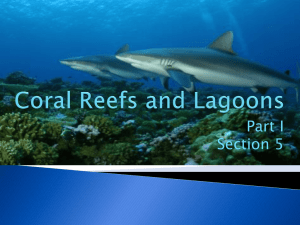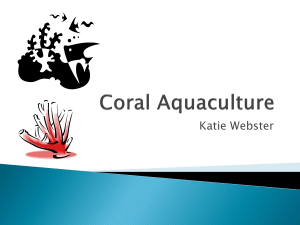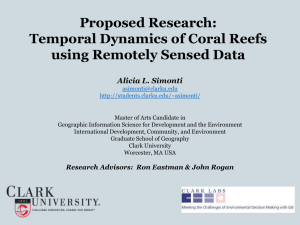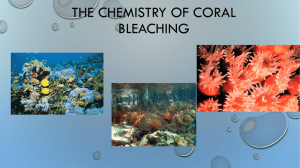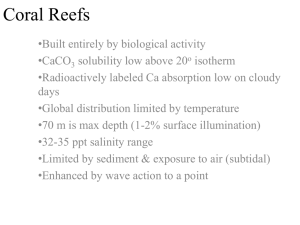Coral Reefs
advertisement
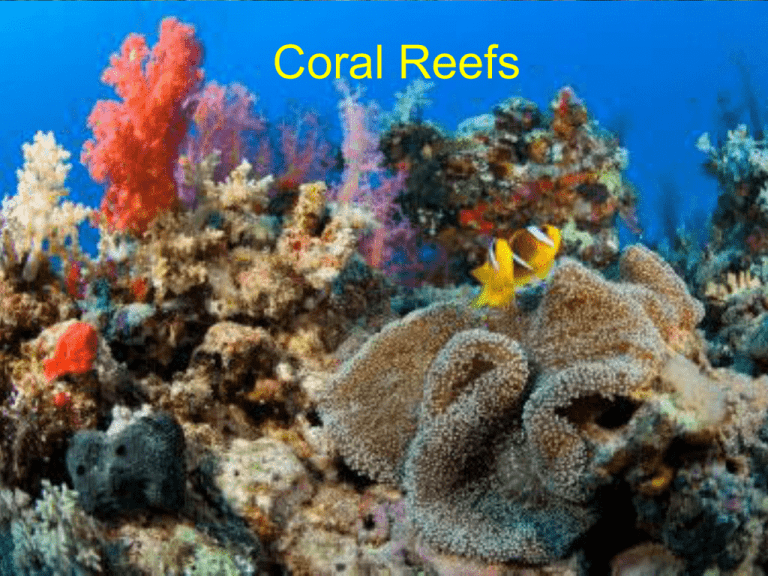
Coral Reefs Coral Reefs Coral Reef Formation Scleractinian Coral Polyps • Scleractinia = stony, hard corals • Coral polyps can be solitary or colonial – Solitary forms are one polyp and one corallite. • Corallite = hard skeleton under the epidermis – Colonial forms can reproduce asexually by cloning, and the new polyp forms another corallite that is attached to the first corallite. • Some produce horizontal, mounding or plate-like corals • Others produce branching, tree-like structures Solitary Corallites Solitary coral corallite, side view (left). Solitary coral corallite top view (right). Solitary Corals • Solitary corals can be found all over the Earth • These species are called ahermatypic. – Ahermatypic corals must capture prey as described for most other cnidaria. Colonial Corals Calyx Septa Colonial mounding coral, side view of corallites (left). Colonial mounding coral, top view of corallites (center). Colonial mounding coral, close up of corallites from a dividing polyp (right). Colonial branching coral, side view of corallites (left). Colonial branching coral, top view of corallites (center). Colonial branching coral, close up of corallites from a dividing polyp (right). Coral Growth Forms Different arrangements of coralites within a colony – Incomplete list Coral Growth Forms 1. solitary (e.g., mushroom corals, Fungia & Cycloseris) 2. dendroid = spreading branches of single corallites 3. phaceloid = distinct parallel-arranged corallites arising from a common source 4. plocoid = corallites with distinct walls united to each other by the coenosteum (e.g., Leptastrea bottae) Dendroid Coral Growth Forms 5. cerioid = prismatic corallites closely appressed and sharing common walls (e.g., crust coral, Leptastrea pupurea, and finger coral, Porites compressa 6. meandroid = several corallites forming a series within the same walls giving the appearance of meandering valleys (e.g., corrugated coral, Pavona varians) 7. thamnasterioid = corallites with confluent septa and lacking defined boundaries (e.g., flat lobe coral, Pavona duerdeni) i Colonial Corallites Coral polyps have retracted into their corallites in the yellow-green coral. You can easily see the radiating septa (walls of calcium from the outside of the circular corallite pointing to the middle) of each corallite. (Plocoid form) Alcyonacea = Soft corals Factors Influencing Coral Colony Morphology • Water motion • Light • Biological Factors – Genetic – Coral symbionts Low light = platelike High light = branches Coral Growth 44 year old coral growth rings. Cross-sections reveal coralgrowth rings that can be used to determine their age. These growth rings can also reveal information about ocean conditions during the coral’s life span. Reef Building Corals • Reef building corals are colonial – create large 'coral heads' that may exist for thousands of years – produce tons of calcium carbonate that becomes the base for the coral reefs growing up and out over time. • Reefs are found in nutrient poor tropical waters that have low productivity. – So no phytoplankton – So no zooplankton – So no food for corals Reef Building Corals • Zooxanthellae are photosynthetic, single-celled dinoflagellates, living in the endodermal tissues of stony corals polyps (intracellularly). • Often, zooxanthellae are concentrated in the polyps’ gastrodermal cells and tentacles. • Deep water and some cold water corals lack zooxanthellae, but virtually all reef-building corals possess them. Reef Building Corals • Reef building corals are hermatypic – Have a symbiotic relationship with photosynthetic zooxanthellae (type of dinoflagellate). – Zooxanthellae provide sugar to the coral polyp and use the metabolic wastes (N & P) from the animal for its own growth. • Most zooxanthellae cannot survive outside of the coral animal's body because there are not enough nutrients in the tropical ocean to allow proper photosynthesis. – Zooxanthellae often give coral species their characteristic color. Hermatypic Ahermatypic Blue-green coral (left) and orange popcorn coral (right) are just a few examples of the variety of colors found in tropical corals. This color may be primarily from their symbiotic zooxanthellae (as in the blue-green coral) -or- produced by the coral animal itself (as in the orange popcorn coral). Role of Zooxanthellae • 94 to 98% of all the organic nutrients are produced by the zooxanthella; they are the main source of the polyps’ organic nutrient requirements. • Thanks to the photosynthetic activities carried out by the zooxanthellae, the calcareous skeleton of hermatypic coral is able to develop 2 to 3 times more quickly in the light than in darkness. Role of Zooxanthellae • Through photosynthesis, zooxanthellae convert carbon dioxide and water into oxygen and carbohydrates. – The coral polyp uses carbohydrates as a nutrient. – The polyp also uses oxygen for respiration and in turns, returns carbon dioxide to the zooxanthellae. – Through this exchange, coral saves energy that would otherwise be used to eliminate the carbon dioxide. Role of Zooxanthellae • During photosynthesis, zooxanthellae “fix” large amounts of carbon, part of which they pass on to their host polyp. • This carbon is largely in the form of glycerol but also includes glucose and alanine. These chemical products are used by the polyp for its metabolic functions or as building blocks in the manufacture of proteins, fats and carbohydrates. • The symbiotic algae also enhance the coral’s ability to synthesize calcium carbonate Role of Zooxanthellae • Nitrogen and phosphorus are cycled between zooxanthellae and coral polyps. – For example, zooxanthellae take in ammonia given off as waste by the polyp, and return amino acids. • Zooxanthellae also promote polyp calcification by removing carbon dioxide during photosynthesis. – Under optimum conditions, this enhanced calcification builds the reef faster than it can be eroded by physical or physical or biological factors. Calcium Carbonate Formation • In the coral Pocillopora damicornis, 35-50% of the total photosynthetic product is excreted by the zooxanthellae, primarily as glycerol. • In the coral tissue, the glycerol is converted largely to lipids, and the skeletal organic matrix has a substantial lipid component, consisting mostly of cetyl palmitate Calcium Carbonate Formation 1. Symbionts synthesize molecules that are essential to the calcification process 2. Symbionts affect the dissolved inorganic carbon equilibrium within coral tissues by taking up CO2 for photosynthesis or by secreting hydroxyl ions that are the product of Carbon Concentrating Mechanisms 3. Symbionts produce energy and O2 that can accelerate the calcification process 4. Symbionts play a role in the removal of substances that would otherwise inhibit calcification (phosphorus). Coral Bleaching • If the zooxanthellae leave or die, the coral becomes 'bleached' (without color) and can die if it does not recover its zooxanthellae. • Causes of coral bleaching – Insufficient light - Zooxanthellae require high amounts of light for photosynthesis. – Silty deposits from land can suffocate a reef. – Zooxanthellae are very sensitive to heat so global climate change is another danger for reefs as sea temperatures rise. Sexual Reproduction This colonial coral is getting ready to spawn, you can see the pink spawn right below the surface of the mature polyps. 75% of corals are broadcast spawners. Sexual reproduction of coral reefs begins with a spawning event. Coral animals reproduce sexually by releasing their gametes (eggs and/or sperm) into the ocean through their mouth (broadcast spawning). Coral spawn are usually tiny pink balls that are released through the mouth of the spawning polyp. Once spawning starts, the ocean is full of these pink bundles. Sexual Reproduction Close up showing zygotes right after fertilization Close up showing several zygotes that have begun cell division. It also shows a micrometer (in millimeters) so you can see the actual size of the spawn. Sexual Reproduction • Brooding species are most often ahermatypic (not reef-building) in areas of high current or wave action. Brooders release only sperm, which is negatively buoyant, sinking on to the waiting egg carriers who harbor unfertilized eggs for weeks. Synchronous spawning events sometimes occurs even with these species. After fertilization, the corals release planula that are ready to settle. Sexual Reproduction Red Coralline Algae Coral Reef Formation Coral Reef Formation Aerial view of the stages of coral reefs (fringing, barrier, atoll). Darwin originally developed the theory of reef formation, (mid-1800’s) and his hypothesis has been supported by the data collected using modern oceanographic technologies. A fringing reef forms along the shoreline of most new tropical islands. A barrier reef forms as the oceanic island begins to sink into Earth's crust due to the absence of volcanic island building forces, the added weight of the coral reef, and erosion at the surface of the island. An atoll forms when the oceanic island sinks below the surface of the ocean but the coral reef continues to grow upward. Eroded reef material may pile up on parts of the reef, creating an area above sea level, an island called a 'cay.' The three stages of coral reef formation fringing, barrier, and atoll. Coral Reef Zonation Biogeographic Profile of Reef A seamount or guyot (gē-ōh) forms when the coral reef cannot keep up with the sinking of the island. Seamounts and guyots are below the surface of the ocean and may be home to a large number of species depending on their location and depth. Beautiful Valuable Valuable Biodiversity Threatened • Natural disturbances: – – – Hurricanes, tsunamis Predation (e.g., coralivorous snails, starfish, parrotfish) Competition with other corals Hurricanes, tsunamis A wave battering a coral reef Parrotfish Predation Predation The crown of thorns sea star on a South Pacific coral reef Competition Coral competition between brain coral and cavernous star coral (left). A close view of two coral species fighting for space (right). The pink species is winning at this time - notice the new white corallites overgrowing the brownish species. Aggressive Behavior • Extruded digestive filaments and sweeper tentacles – Typically, an attack by an aggressive coral on a subordinate neighbor will result in the death of some of the subordinate’s polyps – Experiments also revealed that each coral species attacked only certain species, and each was attacked itself by certain other species, suggesting an “aggressive pecking order” among the corals – Thus, it appears that at least on Jamaican reefs, fastand slow-growing coral species can coexist because the speed at which branching corals grow is balanced by the aggressive nature of massive corals. Threatened • Many natural challenges to corals appear to be accelerated by anthropogenic factors – Competition with macroalgae / blue-green algae (overgrowth / settlement space) accelerated by nutrient input from sewage, fertilizers – Diseases of corals and other reef organisms (fungal, viral, bacterial; white pox disease of once-dominant branching corals now known to be a bacterial agent derived from the human gut) Bleaching Seaweed bloom after bleaching Algal growth Recovery White pox disease on Elkhorn coral. Caused by Serattia marcescens Algal Overgrowth Threatened • Many natural challenges to corals appear to be accelerated by anthropogenic factors – Loss of herbivores that keep algal populations reduced • Loss of herbivorous fish due to overfishing • Loss of Diadema antillarum, long-spined sea urchin, from virus (of unknown origin; susceptibility to diseases greater with additional stresses) • Potential switches in diet of herbivorous community due to changes in algal populations (e.g., potential increase of corallivory by parrotfish as a result of an increase in unpalatable algal species due to loss of grazing by Diadema) Diadema antillarum Threatened • Coastal development • Sewage • Dredging Threatened • • • • Coastal development Sewage Dredging Runoff from construction and agriculture Threatened • • • • Coastal development Sewage Dredging Runoff from construction and agriculture • Marine-based threats Threatened • Overfishing especially for herbivorous species Threatened • Tourism pressure Threatened • Coral Bleaching • Coral Disease • Ocean Acidification Threats to Coral Reefs from Land-based Sources • Sediment Threats to Coral Reefs from Land-based Sources • Sediment • Nutrients Threats from Global Warming Threats from Global Warming • As sea temperatures rise corals, already weakened by the loss of their zooxanthellae, become more prone to attack by pathogenic bacteria; • At the same time, the symbiotic bacteria that live in the corals' guts and assist in their digestive process are weakened, enabling the harmful bacteria to multiply and wreak havoc on the corals. • The corals' most effective defensive mechanism, a surface mucus that acts as a shield against pathogens, may also be inhibited by the combined impact of rising temperatures and the bacterial assault. Resilience of Coral Reefs • Coral reefs appear to be much more resilient to acute natural disturbances than to chronic anthropogenic disturbances. – In the Florida Keys and in other reefs around the world, corals reef ecosystems are being impacted by a host of multiple stressors, and are in very serious decline globally from constellations of local anthropogenic impacts, direct and indirect. Eat coral Parrot Fish Poop sand


